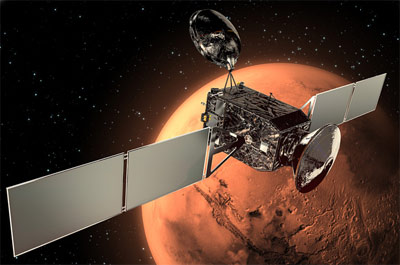Thank you very much for visiting Gunter's Space Page. I hope that this site is useful and informative for you.
If you appreciate the information provided on this site, please consider supporting my work by making a simple and secure donation via PayPal. Please help to run the website and keep everything free of charge. Thank you very much.
TGO (ExoMars 2016) / EDM (Schiaparelli)

TGO with EDM attached [ESA]

EDM (Schiaparelli) [ESA]
The ExoMars Trace Gas Orbiter (TGO) is the first in a planned series of ESA missions leading to the return of a sample from the surface of Mars. Among its objectives is to characterise the planet’s atmosphere, and in particular search for trace gases like methane.
The selected science instruments are:
- Mars Atmospheric Trace Molecule Occultation Spectrometer (MATMOS)
An infrared spectrometer to detect very low concentrations of molecular constituents of the atmosphere. - High-resolution solar occultation and nadir spectrometer (SOIR/NOMAD)
An infrared spectrometer to detect trace constituents in the atmosphere and to map their location on the surface. - ExoMars Climate Sounder (EMCS)
An infrared radiometer to provide daily global measurements of dust, water vapour and chemical species in the atmosphere to aid the analysis of the spectrometer data. - High-resolution Stereo Color Imager (HiSCI)
A camera to provide 4-colour stereo imaging at 2 m resolution per pixel over an 8.5 km swathe. - Mars Atmospheric Global Imaging Experiment (MAGIE)
A wide-angle multi-spectral camera to provide global images in support of the other instruments.
The next ExoMars mission, scheduled for 2018, consists of a European rover with a drill.
EDM (Entry, Descent and Landing Demonstrator Module) Schiaparelli
The EDM (Entry, Descent and Landing Demonstrator Module) - a technology demonstration vehicle carried by the ExoMars Trace Gas Orbiter - was launched in 2016 to demonstrate the capability of the European industry to perform a controlled landing on the surface of Mars. It was named Schiaparelli in November 2013. The preparation for this mission enhances Europe’s expertise and enables the testing of key technologies which could be used in subsequent missions to Mars.
Although designed to demonstrate entry, descent and landing technologies, the EDM also offers limited, but useful, science capabilities. The EDM will deliver a science package that will operate on the surface of Mars for a short duration after landing, planned to last approximately 9 days.
The mission was to be launched on a NASA provided Atlas-5(421)¹ rocket, but when NASA dropped out of the mission, the baselined launch vehicle was changed to a Russian provided Proton-M Briz-M (Ph.3).
On 19 October 2016, TGO entered orbit around Mars. The fate of Schiaparelli in yet unclear.
| Nation: | Europe |
|---|---|
| Type / Application: | Mars orbiter, Mars lander, Mars rover |
| Operator: | ESA |
| Contractors: | Thales Alenia |
| Equipment: | |
| Configuration: | |
| Propulsion: | S400 |
| Power: | 2 deployable solar arrays, batteries (TGO); batteries (EDM) |
| Lifetime: | |
| Mass: | 4332 kg (launch, total); 3732 kg (orbiter, launch); 600 kg (lander, launch) |
| Orbit: | Heliocentric, then Mars orbit |
| Satellite | COSPAR | Date | LS | Launch Vehicle | Remarks | |
|---|---|---|---|---|---|---|
| TGO (ExoMars Orbiter) | 2016-017A | 14.03.2016 | Ba LC-200/39 | Proton-M Briz-M (Ph.3) | with Schiaparelli | |
| EDM (Schiaparelli) | 2016-017# | 14.03.2016 | Ba LC-200/39 | Proton-M Briz-M (Ph.3) | with TGO |
